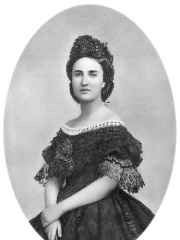


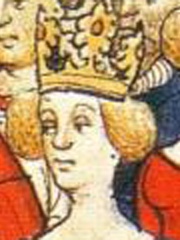
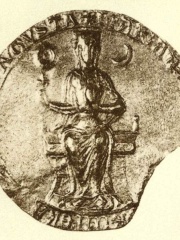

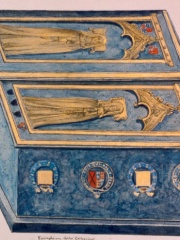
The Most Famous
COMPANIONS from Belgium
This page contains a list of the greatest Belgian Companions. The pantheon dataset contains 784 Companions, 8 of which were born in Belgium. This makes Belgium the birth place of the 15th most number of Companions behind Sweden, and Russia.
Top 8
The following people are considered by Pantheon to be the most legendary Belgian Companions of all time. This list of famous Belgian Companions is sorted by HPI (Historical Popularity Index), a metric that aggregates information on a biography's online popularity.

1. Carlota of Mexico (1840 - 1927)
With an HPI of 79.22, Carlota of Mexico is the most famous Belgian Companion. Her biography has been translated into 41 different languages on wikipedia.
Charlotte of Mexico (French: Marie Charlotte Amélie Augustine Victoire Clémentine Léopoldine; Spanish: María Carlota Amelia Augusta Victoria Clementina Leopoldina; 7 June 1840 – 19 January 1927), known by the Spanish version of her name, Carlota, was by birth a princess of Belgium and member of the House of Wettin in the branch of Saxe-Coburg and Gotha (as such, she was also styled Princess of Saxe-Coburg and Gotha and Duchess in Saxony). As the wife of Archduke Maximilian of Austria, Viceroy of Lombardy–Venetia and later Emperor of Mexico, she became Archduchess of Austria (in 1857) and Empress of Mexico (in 1864). She was the daughter, granddaughter, sister, sister in-law, cousin and wife of reigning or deposed sovereigns throughout Europe and Mexico. From the beginning of her marriage, she feuded with Empress Elisabeth in Vienna, and was glad when her husband was posted to Italy as Viceroy of Lombardy–Venetia. At this time, he was selected by the Emperor Napoleon III as a figurehead for his proposed French empire in Mexico, and Charlotte overcame her husband's doubts about the plan. Maximilian and Charlotte duly arrived in Mexico City in 1864, but their reign lasted little more than three years. She assisted her husband, who let her rule as regent during his absences from Mexico City, for which reason she is considered the first woman to rule in the Americas. When Napoleon III ordered the withdrawal of French military aid intended to support Maximilian, the situation of the Mexican imperial couple became untenable. On her own initiative, Charlotte decided to go personally to Europe in order to attempt a final approach to Paris and the Vatican. She landed in France in August 1866, but suffered the successive refusals of both Napoleon III and Pope Pius IX. In Rome, the failure of her mission appeared to compromise her mental health to the point that an alienist doctor advocated the confinement of Charlotte in Miramare Castle. It was during her stay under house arrest that Maximilian was deposed and executed under Benito Juárez in June 1867. Unaware that she was a widow, Charlotte was brought back to Belgium and confined successively in the Pavilion de Tervueren (in 1867 and again during 1869–1879), the Palace of Laeken (during 1867–1869) and finally at Bouchout Castle in Meise (from 1879), where she remained for the next 48 years in a deleterious mental state, giving rise to much speculation ever since, before dying in 1927 aged 86.

2. Isabella of Austria (1501 - 1526)
With an HPI of 73.18, Isabella of Austria is the 2nd most famous Belgian Companion. Her biography has been translated into 44 different languages.
Isabella of Austria (Isabel; 18 July 1501 – 19 January 1526), also known as Elizabeth, was born an Archduchess of Austria and Infanta of Castile from the House of Habsburg, and subsequently became Queen of Denmark, Norway and Sweden, under the Kalmar Union, as the wife of King Christian II. She was the daughter of King Philip I and Queen Joanna of Castile and the sister of Charles V, Holy Roman Emperor. She ruled Denmark as regent in 1520. Her upbringing, overseen by her aunt Archduchess Margaret, was marked by a comprehensive education in Mechelen under the guidance of notable humanists like Juan Luis Vives and Adrian of Utrecht. In 1514, she entered into a strategic marriage with Christian II of Denmark, Norway, and Sweden. However, the marriage encountered early challenges with diplomatic tensions arising from Christian II's existing relationship with Dyveke Sigbritsdatter, his Dutch mistress. Following Dyveke's death in 1517 the relations between Isabella and her husband significantly improved, and Isabella was entrusted with the position of regent in 1520 and political advisor to the king. In 1523, her husband, King Christian II, was deposed. The political upheaval prompted the Danish royal family, including Isabella and her children, to seek refuge in various European states, such as England, Saxony and the Habsburg Netherlands. During this exile, Isabella strongly advocated for her husband's cause. In 1524, she participated in the Imperial Diet in Nürnberg, where she campaigned on behalf of King Christian II, seeking support for his restoration to the Danish throne. Her travels through Germany, England, and the Netherlands contributed to her evolving religious sympathies for the Protestant movement. Isabella's death in 1526 prompted widespread mourning. She received both Protestant and Catholic communion, but the Habsburgs declared that she had died a fervent Catholic.

3. Matilda of Flanders (1031 - 1083)
With an HPI of 70.25, Matilda of Flanders is the 3rd most famous Belgian Companion. Her biography has been translated into 46 different languages.
Matilda of Flanders (French: Mathilde; Dutch: Machteld; German: Mechtild) (c. 1031 – 2 November 1083) was Queen of England and Duchess of Normandy by marriage to William the Conqueror, and regent of Normandy during his absences from the duchy. She was the mother of at least nine children who survived to adulthood, including two kings, William II and Henry I.

4. Marie of Brabant, Queen of France (1254 - 1322)
With an HPI of 67.59, Marie of Brabant, Queen of France is the 4th most famous Belgian Companion. Her biography has been translated into 37 different languages.
Marie of Brabant (13 May 1254 – 12 January 1322) was Queen of France from 1274 until 1285 as the second wife of King Philip III. Born in Leuven, Brabant, she was a daughter of Henry III, Duke of Brabant, and Adelaide of Burgundy.
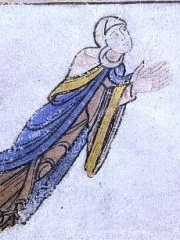
5. Adeliza of Louvain (1103 - 1151)
With an HPI of 64.75, Adeliza of Louvain is the 5th most famous Belgian Companion. Her biography has been translated into 34 different languages.
Adeliza of Louvain (also Adelicia, Adela, Adelais, and Aleidis; c. 1103 – March/April 1151) was Queen of England from 1121 to 1135 as the second wife of King Henry I. Adeliza was the eldest child of Godfrey I, Count of Louvain, and Ida of Chiny. In 1121, aged about 18, Adeliza was married to Henry, who was around 54 years of age. Henry's only legitimate son, William Adelin, had died in 1120, which had prompted Henry to marry again. He hoped to have another son with Adeliza and spent much of his time with her. She seems to have been influential in the promotion of French poetry and other arts at court, but played little part in politics. Though otherwise successful, their marriage produced no children, and Henry decided to leave the throne to his daughter Empress Matilda. Adeliza was among those who swore to support her stepdaughter and did so during her struggle against Henry's nephew Stephen of Blois, who took the throne after Henry's death in 1135. As queen dowager, Adeliza spent three years living in a convent. In 1138, she married again to William d'Aubigny, 1st Earl of Arundel, by whom she had seven children. In 1150, she left her husband to move to the Affligem Abbey in Brabant, where she died the following year.

6. Maria of Brabant, Holy Roman Empress (1190 - 1260)
With an HPI of 64.49, Maria of Brabant, Holy Roman Empress is the 6th most famous Belgian Companion. Her biography has been translated into 21 different languages.
Maria of Brabant (c. 1190 – May/June 1260), a member of the House of Reginar, was Holy Roman Empress from 1214 until 1215 as the second and last wife of the Welf emperor Otto IV.

7. Princess Amalia of Saxe-Weimar-Eisenach (1830 - 1872)
With an HPI of 59.01, Princess Amalia of Saxe-Weimar-Eisenach is the 7th most famous Belgian Companion. Her biography has been translated into 17 different languages.
Princess Amalia of Saxe-Weimar-Eisenach (Amalia Maria da Gloria Augusta; 20 March 1830 – 1 May 1872) was a Dutch princess as the first wife of Prince Henry of the Netherlands, son of king William II of the Netherlands.

8. Katherine Swynford (1350 - 1403)
With an HPI of 58.35, Katherine Swynford is the 8th most famous Belgian Companion. Her biography has been translated into 22 different languages.
Katherine Swynford, Duchess of Lancaster (born Katherine de Roet, c. 1349 – 10 May 1403) was the third wife of John of Gaunt, Duke of Lancaster, the fourth (but third surviving) son of King Edward III. Daughter of a knight from Hainaut, Katherine, whose name is also spelled "Katharine" or "Catherine", was brought up at the English royal court, later found herself in the service of Blanche of Lancaster, the first wife of John of Gaunt. At that time, she was married to Hugh Swynford (or de Swynford), one of the Duke's knights. After the death of the Duchess, Katherine became the lady-in-waiting of her daughters, and also took care of them. After the death of Hugh Swynford, she became a member of the household of the Duke's new wife, Constance of Castile, and she was given management of the estates of her deceased husband in Lincolnshire: Coleby and Kettlethorpe. She soon became the mistress of John of Gaunt. From this connection, at least four children were born, who received the surname Beaufort after one of their father's French estates. Those four children were later recognized and legitimized by the Church. In addition, Gaunt gave his mistress several estates, and also provided her with a generous allowance. Since the relationship between Katherine and John of Gaunt caused public condemnation, in 1381 the Duke was forced to break their relationship. Katherine then settled in a rented house in Lincoln. Despite the formal break, Katherine's relationship with her former lover and the rest of his family continued to be quite cordial. In 1387, she was made a Lady of the Garter by King Richard II, and shortly thereafter she became a member of the household of Mary de Bohun, wife of Henry Bolingbroke, eldest son and heir of John of Gaunt, who later became King of England under the name of Henry IV. In the early 1390s, the love affair between Katherine and John of Gaunt resumed, and after the death of his second wife, the Duke unexpectedly married his mistress in 1396, which caused discontent among the English nobility. However, in the same year, a papal bull was received, recognizing the marriage as valid, and all the children born from the connection were legitimised. After the death of the Duke in 1399, Katherine retired to her rented house in Lincoln, where she died four years later. She was buried at Lincoln Cathedral. Katherine and John of Gaunt's descendants, the Beaufort family, played a major role in the Wars of the Roses. Henry VII, who became King of England in 1485, derived his claim to the throne from his mother, Margaret Beaufort, who was a great-granddaughter of Gaunt and Swynford. His legal claim to the throne, therefore, was through a cognatic and previously illegitimate line. Henry VII's first action was to declare himself king "by right of conquest" retroactively from 21 August 1485, the day before his army defeated King Richard III at the Battle of Bosworth. Through her son, John Beaufort, 1st Earl of Somerset, and her daughter, Joan Beaufort, Countess of Westmorland, Katherine became the ancestor of all English (and later British) kings since Edward IV.
People
Pantheon has 8 people classified as Belgian companions born between 1031 and 1840. Of these 8, none of them are still alive today. The most famous deceased Belgian companions include Carlota of Mexico, Isabella of Austria, and Matilda of Flanders.
Deceased Belgian Companions
Go to all RankingsCarlota of Mexico
1840 - 1927
HPI: 79.22
Isabella of Austria
1501 - 1526
HPI: 73.18
Matilda of Flanders
1031 - 1083
HPI: 70.25
Marie of Brabant, Queen of France
1254 - 1322
HPI: 67.59
Adeliza of Louvain
1103 - 1151
HPI: 64.75
Maria of Brabant, Holy Roman Empress
1190 - 1260
HPI: 64.49
Princess Amalia of Saxe-Weimar-Eisenach
1830 - 1872
HPI: 59.01
Katherine Swynford
1350 - 1403
HPI: 58.35

